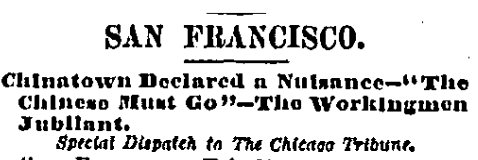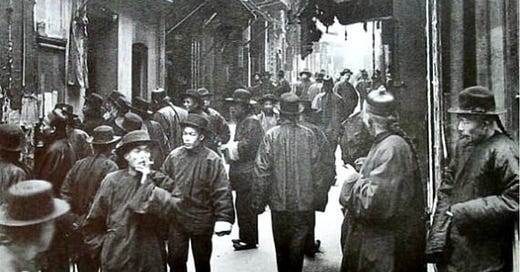San Francisco's Chinatown: A Story of Community in the Face of Oppression
San Francisco’s Chinatown is one of the city's most vibrant and cultured neighborhoods, yet its history is a story of discrimination. In the late 19th century, Chinese people all over the United States were being forced into small neighborhoods due to restrictive housing policies, social norms, and exclusionary laws. These factors confined Chinese Americans to a segregated space but also shaped the economy that is present today. Due to a bright future because of gold and railways, San Francisco’s Chinatown quickly became the country’s largest Chinese settlement.
Chinese immigrants came to San Francisco in large numbers during the Gold Rush of 1849. China was in famine and rebellions following their defeat in the first Opium War, so when news spread of a great opportunity in the Gum San (the Golden Mountain in America) they came to California to strike gold.1 Chinese immigrants also played a big role in building the Transcontinental Railroad. In these fields of work, they encountered hostility and discrimination which drove them to urban areas like San Francisco. From initially laboring gold in mines to constructing the largest railroad at the time, Chinese immigrants continued to be confined to complete hard labor during their time in San Francisco. As more Chinese laborers arrived in San Francisco, economic jealousy grew. As the American economy weakened, Chinese workers became seen as a threat, and discriminatory practices pushed Chinese workers into what is now Chinatown. Chinatown was not a planned neighborhood. Chinatown was shaped out of necessity, as the Chinese were under strong xenophobic pressures and were faced with rejection to live among other San Franciscans. They were forced into a less desirable area of the city, and even though it was overcrowded, a beautifully tight-knit community of their own culture was created.
Not only were Chinese people mistreated in terms of labor, but they also experienced mistreatment in housing practices and schooling. As Chinese people were segregated into Chinatown, white landlords all around San Francisco began to be openly racist and refused to rent to Chinese people. This caused Chinatown to be a place of refuge where they could access housing with ease. As a result, Chinatown became overcrowded with families in tight apartments. The crowded conditions of Chinatown remain notorious in the neighborhood today. Along with racist landlords, Alien Land Laws were put in place to discourage land ownership by Asians in California. Separated schools for Asians were also authorized by law. In the 1850s and 60s, Chinese children were completely excluded from the public school system.2 Specific schools were built in Chinatown just for Chinese students which further isolated them from their white peers. The lack of integration reinforced harmful stereotypes, limiting the opportunities of these students as they were typically given an inferior education.
Discrimination against Chinese people was legalized, which came into play with California’s Second Constitution which was made in 1879.3 This legislature forbade corporations from hiring Chinese people and gave them the authority to remove foreigners outside city limits. One of the most impactful laws that furthered segregation was the Chinese Exclusion Act of 1882. This caused Chinese immigrants to be suspended for 10 years, which also meant banning all citizenship for Chinese people, as outlined in Section 14 of the Act. “SEC. 14. That hereafter no State court or court of the United States shall admit Chinese to citizenship; and all laws in conflict with this act are hereby repealed.”4 Five classes were exempted which were teachers, students, merchants, tourists, and officials. These five classes are what kept Chinatown alive. This act didn't just have an impact on the San Francisco Chinese community, it was also a clear statement that Chinese people were not welcome in American society. Anti-Chinese sentiments were all over not only San Francisco but also California as a whole. The senator at the time, John F. Miller, was a big supporter of the Chinese Exclusion Act and “argued that the Chinese workers were ‘machine-like…of obtuse nerve, but little affected by heat or cold, wiry, sinewy, with muscles of iron.’’5 Chinese people were being dehumanized, which was evident in their sentiments, as well as their inhumane living conditions in Chinatown. Below is an example of common newspaper headlines that worked to spread anti-Chinese beliefs.

The patterns of segregation and discrimination toward Chinese Americans in the late 19th century had lasting effects on their population in San Francisco and beyond. The creation of Chinatown was a double-edged sword, as on one side it created a close community that preserved cultural practices. On the other hand, it isolates the Chinese community from mainstream society and maps them as the target of racism and stereotypes. Economically, they were forced into low-wage jobs and excluded from other economies. Yet, Chinese people in San Francisco didn’t just comply with segregation. A group called The Tongs was created to support the community, create advocacy, and organize forms of resistance.6 Chinese people were being mistreated under the law and 99% of California voters voted against Chinese Immigration in 1879, and ultimately they were restricted from the U.S.7 Yet, San Francisco’s Chinatown still stands today as a symbol of resistance and a lively hub of Chinese tradition, identity, and legacy.
Bibliography:
Britannica Academic, s.v. "Chinese Exclusion Act," accessed January 11, 2025, https://academic-eb-com.ehslibrary.idm.oclc.org/levels/collegiate/article/Chinese-Exclusion-Act/605479#312323.toc.
"Chinese Exclusion Act (1882)." National Archives. https://www.archives.gov/milestone-documents/chinese-exclusion-act.
Noel, Ann M., and Phyllis W. Cheng. "Through Struggle to the Stars: A History of California's Fair Housing Laws." Real Property Law of the State Bar of California. https://clkrep.lacity.org/onlinedocs/2011/11-0262_misc_2-8-12e.pdf.
"The Story of Chinatown." PBS. https://www.pbs.org/kqed/chinatown/resourceguide/story.html.
Young, John P. "The Support of the Anti-Oriental Movement." The Annals of the American Academy of Political and Social Science 34, no. 2 (1909): 11–18. http://www.jstor.org/stable/1011205.
Zelenko, Michael. "The Tongs of Chinatown: A Conversation with Bill Lee." Found SF. https://www.foundsf.org/index.php?title=The_Tongs_of_Chinatown.
"The Story of Chinatown." PBS. https://www.pbs.org/kqed/chinatown/resourceguide/story.html.
Noel, Ann M., and Phyllis W. Cheng. "Through Struggle to the Stars: A History of California's Fair Housing Laws." Real Property Law of the State Bar of California. https://clkrep.lacity.org/onlinedocs/2011/11-0262_misc_2-8-12e.pdf.
"The Story of Chinatown." PBS. https://www.pbs.org/kqed/chinatown/resourceguide/story.html.
"Chinese Exclusion Act (1882)." National Archives. https://www.archives.gov/milestone-documents/chinese-exclusion-act.
Britannica Academic, s.v. "Chinese Exclusion Act," accessed January 11, 2025, https://academic-eb-com.ehslibrary.idm.oclc.org/levels/collegiate/article/Chinese-Exclusion-Act/605479#312323.toc.
Zelenko, Michael. "The Tongs of Chinatown: A Conversation with Bill Lee." Found SF. https://www.foundsf.org/index.php?title=The_Tongs_of_Chinatown.
Young, John P. "The Support of the Anti-Oriental Movement." The Annals of the American Academy of Political and Social Science 34, no. 2 (1909): 11–18. http://www.jstor.org/stable/1011205.





